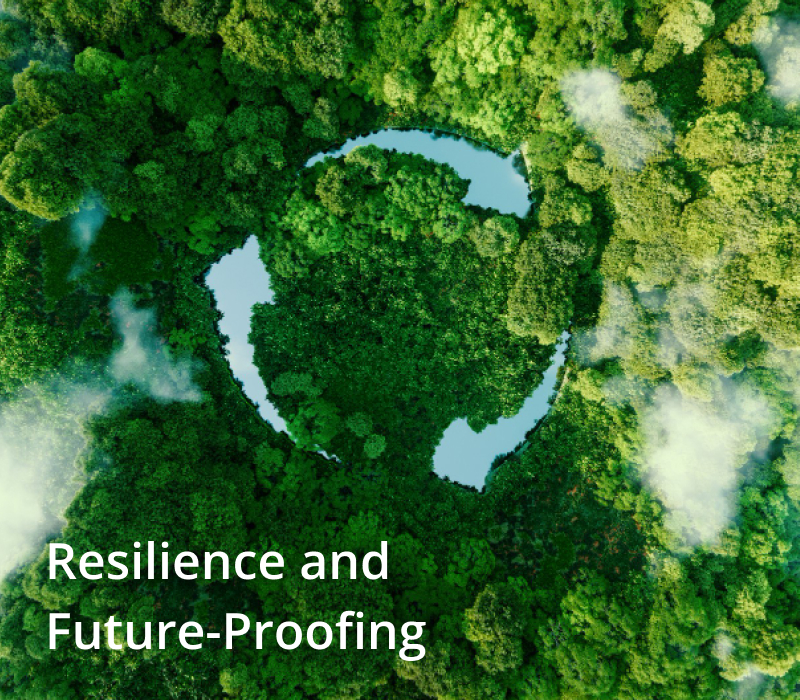Blog
Co-authored by Factum Global and Whitney Buchman, Associate Consultant and Founder of Illustra Impact LLC
Sustainability continues to emerge as a critical imperative for organizations across all sectors to recognize and take action. Associations, in particular, hold a unique position of influence within their industries and communities, making their commitment to sustainability essential. Afterall, the heart of sustainability is all about the people. In this article, we will delve into the importance of sustainability measures for associations and explore how they can drive positive change and lead by example.
The Role of Associations in Fostering Sustainability
Associations play a multifaceted role in fostering sustainability, serving as catalysts for change, industry leaders, reputation builders, and champions of resilience. Let’s delve a bit deeper:




1. Influence:
Associations wield considerable influence within their industries, representing the collective voice of their members and stakeholders. In doing so, they have the power to shape industry norms, standards, and practices. By leveraging their influence, associations can drive sustainability initiatives, advocate for policy changes, and promote best practices that benefit both businesses and the environment. Their leadership can inspire widespread adoption of sustainable principles, fostering a culture of environmental responsibility across the industry.
2. Industry Leadership:
As stewards of their respective industries, associations have a responsibility to prioritize sustainability and environmental stewardship. This entails not only adhering to sustainable practices within their own operations but also advocating for sustainability across the industry.
Let’s spotlight the Association of Zoos and Aquariums (AZA) for a moment. AZA is a nonprofit organization dedicated to advancing animal welfare, conservation, and education within zoos and aquariums. AZA promotes sustainability through its Green Office Program, which provides resources and guidelines for member institutions to reduce their environmental footprint and promote environmental stewardship. Through initiatives such as energy conservation, waste reduction, and sustainable procurement, AZA empowers zoos and aquariums to minimize their impact on the environment and inspire visitors to take action for conservation. By integrating sustainability into zoo and aquarium operations, AZA demonstrates its commitment to environmental sustainability and wildlife conservation.
Associations can play a vital role in mitigating the environmental impact of industry operations, reducing resource consumption, minimizing pollution, and promoting responsible practices that benefit ecosystems and communities. By championing sustainability, associations demonstrate their commitment to the long-term health and sustainability of their industries.
3. Reputation and Branding:
Embracing sustainability can enhance an association’s reputation and brand value, positioning it as a leader in its field. Associations that prioritize sustainability are viewed as forward-thinking, responsible, and socially conscious organizations, attracting like-minded members, stakeholders, and partners.
Take the International Association of Exhibitions and Events (IAEE) as an example. IAEE is a global association representing the exhibitions and events industry. It recognizes the importance of sustainability in event management and provides resources, guidance, and certification programs to help other associations and event planners minimize their environmental impact. Through its Sustainable Exhibitions Committee, for example, IAEE promotes best practices for reducing carbon emissions, waste generation, and resource consumption in event planning. By providing education, training, and support, IAEE empowers associations to host sustainable events that contribute to positive environmental outcomes and leave the event destination a better place than when they arrived.
By aligning their brand with sustainability principles, associations can differentiate themselves from competitors, build trust with their constituents, and strengthen their position as influential industry leaders. A strong sustainability reputation can enhance member loyalty, attract new members, and foster positive relationships with stakeholders and the public.
4. Resilience and Future-Proofing:
Resilience is essential for organizations to thrive in the face of evolving global challenges such as climate change, resource scarcity, and regulatory pressures. Sustainability measures can enhance the resilience of associations and their members by mitigating risks, reducing vulnerabilities, and fostering adaptability. By adopting sustainable practices with clear key performance metrics (KPIs), associations can future-proof their operations, position themselves for long-term success, and maintain relevance in a rapidly evolving landscape. Sustainability-driven innovation can lead to new opportunities for growth, differentiation, and competitive advantage, ensuring the continued prosperity of associations and their constituents.
AGU CASE STUDY: Driving Sustainability in Associations
The American Geophysical Union (AGU), a global association of Earth and space scientists, exemplifies a commitment to sustainability through its comprehensive sustainability initiatives. With a mission to promote discovery in Earth and space for the benefit of humanity, AGU integrates sustainability into all of its operations, events, publications, and advocacy efforts.
AGU’s Sustainable Event Practices: The AGU Fall Meeting, AGU’s main annual event, is one of the largest Earth and space science conferences globally, drawing thousands of attendees from around the world. AGU prioritizes sustainability in the planning and execution of the Meeting, implementing initiatives to reduce its environmental footprint and promote responsible practices.
Venue Selection and Transportation: AGU selects conference venues with strong commitments to sustainability, including green certifications and environmentally friendly practices. The organization prioritizes venues with easy access to public transportation, reducing the carbon footprint of attendees traveling to the event. By choosing sustainable venues, AGU demonstrates its dedication to environmental stewardship and sets a positive example for conference organizers worldwide.
Sustainable Catering and Food Practices: They also partner with caterers who prioritize sustainable practices, including sourcing local and organic ingredients, minimizing food waste, and reducing single-use plastics. It promotes sustainable food choices at its events, offering vegetarian and plant-based options to attendees and encouraging mindful consumption. By promoting sustainable catering practices, AGU reduces the environmental impact of its events and supports local food systems.
Waste Reduction and Recycling: AGU even implements waste reduction and recycling programs at its events, providing recycling bins, composting facilities, and reusable materials to minimize waste generation! The organization encourages attendees to use refillable water bottles, reusable conference bags, and digital resources to reduce their environmental footprint. By prioritizing waste reduction and recycling, AGU demonstrates its commitment to sustainability and fosters a culture of environmental responsibility among its members and stakeholders.
Engagement and Education: AGU engages conference attendees through educational initiatives and awareness campaigns focused on sustainability. It provides resources, information, and guidance on sustainable practices, empowering attendees to make informed choices and take action to reduce their environmental impact. By promoting sustainability education and engagement, AGU fosters a sense of collective responsibility for the planet and inspires positive change within the scientific community.
In addition to events, AGU’s incredible net zero energy renovated building in Washington, DC – complete with more than 700 solar panels on its roof, AGU is undoubtedly leading the way.
Photo credit: American Geophysical Union
How to Measure Impact and Evaluate Success
To assess the effectiveness of sustainability initiatives, associations can employ various metrics and evaluation methods:
1. Environmental Impact Assessments:
Associations can conduct environmental impact assessments to quantify the environmental footprint of their operations, events, and initiatives. This includes assessing energy consumption, greenhouse gas emissions, water usage, waste generation, and resource consumption. By analyzing these metrics, associations can identify areas for improvement, set targets for reducing their environmental impact, and track progress over time.
2. Member Engagement and Feedback:
Gathering feedback from members through surveys, focus groups, and evaluations provides insights into the effectiveness of sustainability initiatives and member engagement. Associations can assess member satisfaction with sustainability efforts, identify barriers to participation, and solicit suggestions for improvement. By incorporating member feedback into sustainability planning and decision-making, associations can ensure that initiatives are relevant, meaningful, and impactful.
3. Financial Performance:
Sustainability initiatives can have financial implications for associations, including cost savings from energy efficiency measures, revenue generation from green initiatives, and potential risks from environmental liabilities. Associations can evaluate the financial performance of sustainability efforts to ensure alignment with organizational strategies, goals, and objectives. By having clearly defined metrics and conducting cost-benefit analyses and financial assessments, associations can demonstrate the economic viability of sustainability initiatives and make informed investment decisions.
4. Policy and Advocacy Impact:
Associations can also measure the impact of their advocacy efforts on sustainability-related policies, regulations, and initiatives. This includes tracking legislative actions, policy outcomes, and public awareness on key environmental issues. By assessing the influence of advocacy campaigns, associations can identify key stakeholders, evaluate progress toward policy objectives, and demonstrate the effectiveness of their advocacy efforts on a global level.
Sustainability is not just a choice—it is a strategic imperative for associations in today’s world. By prioritizing sustainability measures, associations can fulfill their role as leaders, stewards, and influencers within their industries and communities. From driving positive change through advocacy and policy initiatives to promoting responsible practices among members and stakeholders, associations have the power to make a significant impact on the environment and contribute to a more sustainable future for all.


